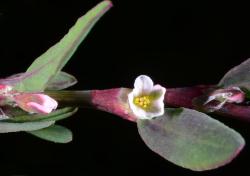- Taxon
- Gallery
Glabrous annual, sometimes biennial, mostly prostrate or decumbent, sometimes spreading; stems numerous, slender, wiry, to c. 1 m long, often forming large, flat mats to c. 1.5 m diam.; taproot fairly stout. Lvs of young and main stems often twice as large as those of branches, subsessile or with petiole to 1 cm long. Lamina (3)–10–40 × (0.5)–3–15 mm, lanceolate to elliptic or ovate, rarely obovate or linear, green or glaucescent, sometimes purplish, entire; base cuneate or rounded; apex acute or subacute; branch lvs sometimes < 5 mm long. Ochreae initially 2–5 mm long, longer in young plants, silvery-hyaline, ± acute, becoming brown, soon lacerate, often enclosing petiole. Fls 1–6 in fascicles in the axils of lvs, extending almost to stem bases; pedicels enclosed by ochreae. Perianth 2–3 mm long at anthesis, usually united for 1/4-⅓ length; segments strongly imbricate, rarely only slightly imbricate, ± oblong, glabrous; margins and apex white, pale pink, or rose, often variously coloured on the same plant, accrescent. Nut 2–3 mm long, ovoid to almost biconvex, dark reddish brown, ± shining, finely striate or granular, regularly trigonous or sometimes 1 side wider or narrower than others, enclosed in perianth or with apex protruding.
[From: Webb et al. (1988) Flora of New Zealand. Volume 4.]
Flowering: Nov.–Jun.




